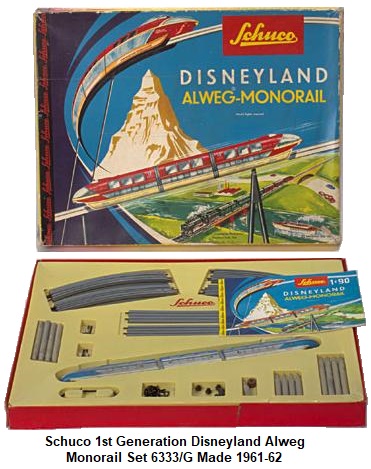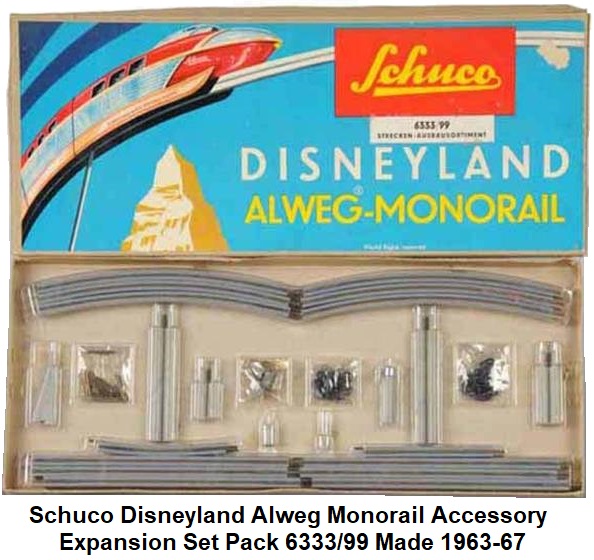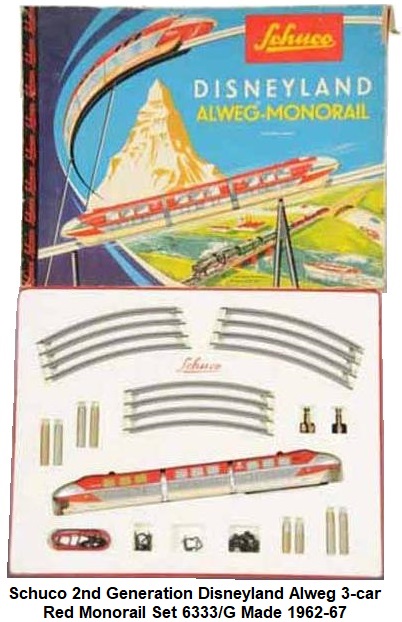 Schuco is a German toy maker founded on November 16, 1912 by Heinrich Müller and the businessman Heinrich Schreyer
in Nuremberg, Germany's early toy capital. Its specialty was usually cars and trucks in both tin and diecast.
The company went bankrupt in 1976 but was reorganized in 1993 and then totally independent again by 1996.
Schuco is a German toy maker founded on November 16, 1912 by Heinrich Müller and the businessman Heinrich Schreyer
in Nuremberg, Germany's early toy capital. Its specialty was usually cars and trucks in both tin and diecast.
The company went bankrupt in 1976 but was reorganized in 1993 and then totally independent again by 1996.
Heinrich Müller had first started designing toys at the early age of 17 in 1905. To expand his
knowledge and skills, he worked as a technician and designer for several years in the prestigious
Bing Toys factory. Müller later partnered with merchant Heinrich Schreyer to found their
new toy manufacturing company. Originally named Spielzeugfirma Schreyer & Co, the firm changed its name to the
more succinct Schuco in 1921. The newly chosen company name was simply the abbreviation for Schreyer & Co. When
the company started in 1912, it made unique clockwork tin toys. The first headquarters was located in the Nuremberg
Roonstraße. Production took place in 150 square meters by 10 employees. The focus was on making felt and plush toys.
These premises rapidly became too small and the company first moved to the Celtisstraße, and later to the Singerstraße.
World War I brought a setback, as both company owners were drafted. Schreyer left the company after the end of the war
because he did not believe that the toys being produced would be successful. Heinrich Müller stayed faithful to his
vision and sought out a new financial partner, in the form of businessman Adolf Kahn.
In the 1920's Schuco introduced its famous Pick-Pick bird (over 20 million were made up until the
1960's). The company grew rapidly and was now employing 300 permanent workers and an additional 100 part-time seasonal
staff. Müller's strategy was to create toys that were timely to world events. The non-stop Atlantic ocean flight of
Charles Lindbergh in 1927 was followed by Schuco's creation of a model of the "Spirit of St. Louis". Space limitations
required another move to larger production facilities in 1928 to a former shoe factory at 28-32 Fürth road.
In 1935 one of the first Schuco patent motor cars was produced, starting a legacy of producing toy motor vehicles that
have always been the company's main offering. Production was halted during World War II and in the late 1940's production
began again with tin toys, this time focused more on the American market. New factory buildings were constructed in
Nuremberg in 1952 and 1954. Schuco rapidly became one of the largest toy producers in Germany releasing at least eight
new products every year. Heinrich Müller died on June 3 of 1958. His passing had no negative effects on the firm's
operations as the employees continued the business in the spirit of the company's founder. Alexander Girz became the
chief desiner.

 Unlike other popular toy manufacturers from this era such as Lionel and
Gilbert/American Flyer, Schuco only made and sold a very small amount of toy trains
and accessories. In the 1960's Schuco came out with an electric powered 1:90 scale model of the Disneyland Mark I
Alweg monorail under license from Disney Corp. Alexander Girz had visited and ridden on the Disneyland Alweg monorail and
believed that it would be a great item to model as an operating toy. All of the model's parts including track,
switches, and pylons had to be designed from scratch. Like the prototype that operated at Disneyland,
Schuco produced both a red and a blue version. There was also an all silver non-prototypical version created.
The monorail model trains were constructed of lithographed
tin and hard plastic, and were authentically detailed, bearing decals that read "Disneyland-Alweg Monorail System/Santa
Fe & Disneyland RY." The Schuco Disneyland Alweg monorail trains came packaged in sets of 3 or 4 cars that included
track and piers to create a simple operating layout. The monorail was powered by means of a 12-17 volt DC transformer,
although this was an accessory that was sold separately, not as part of the sets. Accessory packs to expand the track
layout were also available for separate purchase, as well as operating switches and working semaphores.
Unlike other popular toy manufacturers from this era such as Lionel and
Gilbert/American Flyer, Schuco only made and sold a very small amount of toy trains
and accessories. In the 1960's Schuco came out with an electric powered 1:90 scale model of the Disneyland Mark I
Alweg monorail under license from Disney Corp. Alexander Girz had visited and ridden on the Disneyland Alweg monorail and
believed that it would be a great item to model as an operating toy. All of the model's parts including track,
switches, and pylons had to be designed from scratch. Like the prototype that operated at Disneyland,
Schuco produced both a red and a blue version. There was also an all silver non-prototypical version created.
The monorail model trains were constructed of lithographed
tin and hard plastic, and were authentically detailed, bearing decals that read "Disneyland-Alweg Monorail System/Santa
Fe & Disneyland RY." The Schuco Disneyland Alweg monorail trains came packaged in sets of 3 or 4 cars that included
track and piers to create a simple operating layout. The monorail was powered by means of a 12-17 volt DC transformer,
although this was an accessory that was sold separately, not as part of the sets. Accessory packs to expand the track
layout were also available for separate purchase, as well as operating switches and working semaphores.
The monorail models were manufactured by Schuco from October 1961 until Christmas of 1967 with some
left over sets trickling out of the factory in 1968. The monorails never appeared in the 1969 catalog which implies
that Schuco no longer intended to promote them. The line was a huge disappointment since they never sold well.
One of the reasons for the sets' lack of success was because they were very expensive in terms of a toy during the
1960's. It is believed that the small sets (6333/G) started at $39.95 (later reduced to $25), the middle set (American Set,
also referred to as the H or W set) for $49.95 (reduced to $39.95 by Christmas of 1964), and the large set (6333/S),
which came with 4 cars and 2 switches, for a whopping $89.95.

Alweg was a German based design firm best remembered for their role in building the original Disneyland
Monorail System, which opened in 1959, and the Seattle Center Monorail, which opened for the 1962 Century 21 Exposition.
Both of these systems remain operational today, with the Seattle Center Monorail still using the original Alweg trains
which have traveled over one million miles. A third system, built in Turin for the Italia 61 exposition remained unused a
few months after the exposition closed and was destroyed by a fire in the late 1970's.
 According to a book published by Schuco in 2012 to commemorate their 100 year anniversary, the company
invested in excess of $250,000 Deutsche marks (the official currency of West Germany from 1948 until 1990) in the
development and design of the Disneyland Alweg monorail toys. Initial internal discussion involved debate as to whether
the monorail toy should be in 1:90 scale or in 1:87. 1:87 was the same scale used by the popular HO gauge trains produced
during this era. Since Schuco already produced a popular model automobile line in 1:90 scale, the decision was made by
the then head of Schuco, Alexander Girz, to manufacture the monorails in 1:90. Schuco designed some unique features into their
monorails. By simply
flipping a switch on the motor unit, it was possible to select which rail that a particular train would obtain its
electrical power from; either the top and left rail or the top and right rail. Therefore, with two separate transformers,
it was possible to run two trains on the same track, but yet have complete control of each train's speed.
According to a book published by Schuco in 2012 to commemorate their 100 year anniversary, the company
invested in excess of $250,000 Deutsche marks (the official currency of West Germany from 1948 until 1990) in the
development and design of the Disneyland Alweg monorail toys. Initial internal discussion involved debate as to whether
the monorail toy should be in 1:90 scale or in 1:87. 1:87 was the same scale used by the popular HO gauge trains produced
during this era. Since Schuco already produced a popular model automobile line in 1:90 scale, the decision was made by
the then head of Schuco, Alexander Girz, to manufacture the monorails in 1:90. Schuco designed some unique features into their
monorails. By simply
flipping a switch on the motor unit, it was possible to select which rail that a particular train would obtain its
electrical power from; either the top and left rail or the top and right rail. Therefore, with two separate transformers,
it was possible to run two trains on the same track, but yet have complete control of each train's speed.
A listing and artist rendering that appeared in the Schuco 1964 catalog indicated that the company
had plans to produce a model of the Seattle Alweg monorail as well. However, this model was never manufactured.
Although not very popular when they were originally manufactured, the Disneyland Alweg monorail models are highly
prized by collectors today. The monorails appear to be holding their value, though they are not as expensive as they were
in the 1990's.
In the 1960's and 1970's the sales of Schuco's die-cast zinc tin and plastic
toys declined greatly. The company declared bankruptcy in 1976. An English company named Dunbee-Combex-Marx (DCM) then
acquired Schuco (or large parts of it), but it too went bankrupt in 1980. Eventually, rival German toymaker Gama Toys,
acquired the rights to Schuco in the mid-1980's, and, for a time, new Gama Toys were 1:43 scale Schucos put directly
into Gama boxes - with no name change on the base of the vehicle. In the U.S. during the 1980's Schuco toys were marketed
by the Lilliput Motor Company of Yerington, Nevada, with
Lilliput appearing right on the colorful boxes. This company is not affiliated nor should it be confused with
Liliput Trains, a subsidiary of Bachmann Industries.
In 1993 Gama-Schuco combined with Trix, a maker of small scale trains, and a company previously
associated with Märklin. In 1996, Schuco became independent again and saw a revival, producing
a wide variety of collectible models, with many newly designed castings, but many being exact replicas of earlier lines.

In 1999, Schuco was acquired by the Simba Dickie Group and model boxes were labeled with stickers saying
"Dickie Schuco" even if it was old inventory. Simba Dickie had previously absorbed Smoby which had previously purchased
French Majorette which in turn had acquired Solido. Majorette and Solido were apparently spun off, but by 2009, Schuco
was healthy enough to acquire Schabak.
Schuco no longer makes the models of the famous Alweg monorail. They mainly produce street
vehicles in different scales. There are classic and newer lines, all beloved by collectors. The quality of the models
is superior to the average toy model vehicles, therefore unit prices tend to be higher, but with the conglomeration of
so many venerable brands in one company the final outcome of all the brands remains to be seen. On March 21, 2013, the
Simba Dickie Group added another famous old toy company to its marquee with the acquisition of German model train manufacturer
Märklin. Märklin had previously acquired the assets of G scale train manufacturer
Ernst Paul Lehmann Patentwerk/Lehmann Gross Bahn (better known as LGB trains) in 2006 and of Hubner
in 2007.
Link to Schuco web site.
